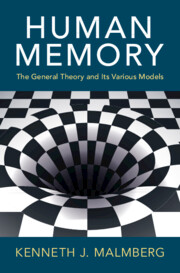Book contents
- Human Memory
- Human Memory
- Copyright page
- Contents
- Figures
- Foreword
- Preface
- Acknowledgments
- Chapter 1 Introduction
- Chapter 2 Models of Cognitive Control, Storage, and Retrieval
- Chapter 3 Search and Detection
- Chapter 4 Sequential Effects
- Chapter 5 Forgetting
- Chapter 6 Differentiation
- Chapter 7 Knowledge
- Chapter 8 Modeling the Consequences of Testing Memory
- Chapter 9 The Buffer Model Revisited
- References
- Index
Chapter 2 - Models of Cognitive Control, Storage, and Retrieval
Published online by Cambridge University Press: 17 January 2025
- Human Memory
- Human Memory
- Copyright page
- Contents
- Figures
- Foreword
- Preface
- Acknowledgments
- Chapter 1 Introduction
- Chapter 2 Models of Cognitive Control, Storage, and Retrieval
- Chapter 3 Search and Detection
- Chapter 4 Sequential Effects
- Chapter 5 Forgetting
- Chapter 6 Differentiation
- Chapter 7 Knowledge
- Chapter 8 Modeling the Consequences of Testing Memory
- Chapter 9 The Buffer Model Revisited
- References
- Index
Summary
The formal details of the modeling frameworks that have been most useful in accounting for specific empirical phenomena are presented. At the highest, most abstract level are mathematical models used to describe how the contents of the short-term store are managed. At the middle level, the search of associative memory models (SAM) describe how information is transferred from the short-term store to the long-term store, and how memories in the long-term store are retrieved to the short-term store. At the lowest, most complex level, the retrieving effectively from memory (REM) models are described, which implement multidimensional memory representations and rational decision processes.
Information
- Type
- Chapter
- Information
- Human MemoryThe General Theory and Its Various Models, pp. 27 - 50Publisher: Cambridge University PressPrint publication year: 2024
